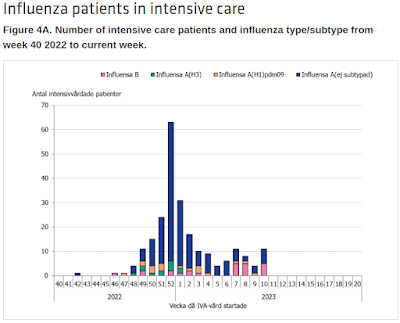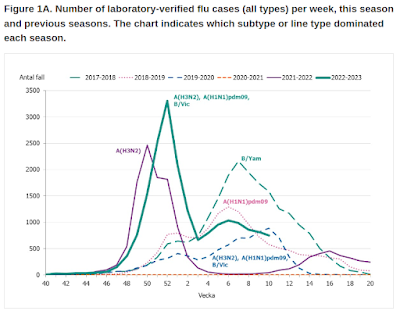
Credit Swedish Public Health Agency
It isn't readily apparent what `a few cases' means, since no hard numbers are provided. In Sweden, much as we've seen in the United States, flu season peaked early (in December) and after a sharp fall, has leveled off. Influenza B however, often appears in the spring after influenza A has run its course.
While influenza B infection can be every bit as severe as influenza A (see Influenza B: A Virus Not To Be Underestimated), reports of severe neurological or cardiac complications are uncommon.
The ECDC included the following update in yesterdays' Communicable Disease Threat Report. I'll have a bit more after the break.
#17,356
We've a bit of a medical mystery this morning, as Sweden is reporting an unusual spike in severe influenza B infections among young people which appears to be clustered in the Örebro County region. More than half of all influenza ICU admission in Sweden the past few weeks (see chart above) have been for Influenza B.
First a (translated) statement from Sweden's Public Health Agency.The Public Health Agency, together with the Infection Control Unit in the Örebro County region, is investigating a few cases of influenza B with serious complications that have been reported in the region. The cases, which have been among people under the age of 18 without an underlying disease or condition, have been very seriously ill with complications such as myocarditis or encephalitis. It is already known that the reported complications can occur in connection with influenza infection, but this is unusual.
The investigation aims to assess whether there are more influenza B cases with serious complications than expected and whether there is any common contributing cause in addition to the influenza infection. Therefore, the Public Health Authority has asked other infection control units to investigate whether there are similar cases in other regions. The Public Health Authority is also investigating whether there are similar accumulations of cases in other European countries, but nothing of the sort has been reported so far.
Virological analyzes show that all Swedish characterized influenza B strains in the 2022–2023 season, including samples from severe cases, belong to the same genetic group of lineage type B/Victoria that dominates in the rest of Europe and that is included in the season's influenza vaccines.
Since March 14, Region Örebro län has been offering, in consultation with the Public Health Authority, school-aged children free vaccination against influenza for a limited period.
It isn't readily apparent what `a few cases' means, since no hard numbers are provided. In Sweden, much as we've seen in the United States, flu season peaked early (in December) and after a sharp fall, has leveled off. Influenza B however, often appears in the spring after influenza A has run its course.
While influenza B infection can be every bit as severe as influenza A (see Influenza B: A Virus Not To Be Underestimated), reports of severe neurological or cardiac complications are uncommon.
The ECDC included the following update in yesterdays' Communicable Disease Threat Report. I'll have a bit more after the break.
Severe Cases of Influenza B among Young People
Overview
As of 15 March 2023, Sweden has reported cases of laboratory-confirmed influenza B infection, associated with severe outcomes among children and adolescents with geographical proximity to one another. There were no underlying medical conditions.
Complications included myocarditis and meningoencephalitis. All cases have been severe, requiring critical intensive care.
As of 14 March, influenza vaccination is being offered free of charge to children 6-17 years of age in the region in question through the regional healthcare system. Case finding is ongoing to further investigate whether the cases are within the expected range of severe outcomes and explanatory factors.
So far, sequencing has been completed for some of the cases, all B/Victoria lineage. Phylogenetic analysis of HA1 suggests they are genetically similar to other circulating influenza B viruses in Sweden this season, belonging to genetic subgroup V1A.3a.2. This is the dominant subgroup across Europe and the northern hemisphere in the 2022-23 season and the northern hemisphere 2022-23 and 2023-24 influenza vaccine strain (B/Austria/1359417/2021-like virus) [1].
No antiviral resistance in influenza B viruses has been observed in the current season in Sweden or globally [2]. Further analysis of other samples from both severe and mild cases in the region and from the rest of Sweden is ongoing.
ECDC assessment
Very few influenza virus detections in humans were observed in the EU/EEA during the 2020/21 and 2021/22 seasons. The 2022/23 influenza season started early (W45-2022), with widespread circulation and intensity levels comparable to pre-COVID-19-pandemic seasons. In Sweden, influenza type A(H3N2) and A(H1N1)pdm09 cocirculated between W45-2022 and W07-2023, with virus detections peaking in W52-2022. Influenza detections have gradually declined since W52-2022, albeit with the proportion of influenza type B virus detections among all positive samples increasing since W07-2023.
This mirrors the trend observed across the EU/EEA. Although the influenza type B virus cases reported in Sweden have been detected in the same region, only two confirmed and one suspected case are known to share an epidemiological link. So far, there is no indication that the influenza B viruses circulating in Sweden differ from those circulating elsewhere in the EU/EEA or globally.
It is unknown whether cases had been vaccinated against seasonal influenza or had had COVID-19 prior to the onset of the influenza infection. None of the cases have a co-infection with COVID-19 and influenza B. Reduced circulation of, and population exposure to influenza viruses during the preceding seasons may have had an impact on immunity to the influenza viruses currently in circulation, so it is important to remain vigilant for signals of increased severity in different population groups.
Actions
An EpiPulse event item has been launched to facilitate reporting of epidemiological information from all EU/EEA countries. ECDC will continue to monitor the event in EpiPulse and via Epidemic Intelligence activities. ECDC encourages countries to provide information on cases of laboratory-confirmed influenza B infection observed among children and adolescents, associated with severe outcomes. Countries are encouraged to determine the lineage, as well as perform genetic and antigenic characterisation for such cases.
It would also be advisable for countries to share either clinical specimens or virus isolates with the WHO Collaborating Centre (London) for further characterisation. Where available, countries are asked to provide GISAID accession numbers for sequenced isolates, to enable genomic analyses and comparisons. ECDC can offer sequencing and virus characterisation support through contracted activities.
While unusual, this isn't the first time we've seen severe influenza B reported.
- The United States saw an unusually severe influenza outbreak in both 1962 and 1979 (see Morbidity and Mortality Associated with Influenza B in the United States, 1979-1980. A Report from the Center for Disease Control).
- In 2010, in Attack Of The Killer `B’s, we looked at reports of Co-infection of Influenza B and Streptococci causing Severe Pneumonia and Septic Shock in Healthy Women.
- In 2012 Lisa Schnirring of CIDRAP News wrote a story on a JID study (Myocardial Injury and Bacterial Pneumonia Contribute to the Pathogenesis of Fatal Influenza B Virus Infection) entitled Study finds influenza B may be more severe than thought.
- In Denmark's Flu 2017-18 Season: Attack of The Killer B's, we looked at an analysis from the Statens Serum Institute (SSI) which described an unusually severe influenza B dominated flu season in Denmark.
Exactly what is driving Sweden's spike in severe influenza B infections isn't clear, although plenty of theories abound. So far, it appears to be localized, but it is certainly worth keeping an eye on it.
Stay tuned.
